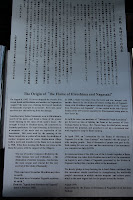

~ For my most honored Son, Nicholas. Forgive the spelling on this piece as I have not had a chance to research the exact spelling.
LAUGH. This is what Kyogen means to me. Kyogen is a play that expresses human foibles through the use of humor and wit. The piece we witnessed was called “The Inherited Cramp”. Don Kenny, an American who has studied the Japanese art of Kyogen for over 30 years translated the Japanese play into English so that we could understand what we were watching. You will be able to view this play from a link I will later post in the blog when I get back from Tokyo, so I will not tell you the story now. Suffice it to say that it tells a simple story of a master and his servant which had me laughing out loud.
Kyogen is only one of the Traditional Performing Arts of Japan. Gaguku, the most ancient Japanese art form dating back to 1500 years ago, blends instrumental music and dance into a stylized, slow moving and ethereal performance. In order to fully experience this art form, it was explained to me that you need to slow your eyes down to the pace of the dancers and music. When you do this you can see the supreme effort that is exerted in each movement and then be transported into the tension that is created between the slow movement and the thrilling visual display of the costumes.
Noh and Kilgan, which date back to 600 years ago is characterized as heavy and tragic, similar to Italian Opera. All of the main characters are ghosts and therefore dead before the play begins. The theme of most of these plays focuses on a traveling priest who meets up with ghosts and tries to help them leave the burdens of earth behind and ascend into paradise. The main characters always wear a mask – there are over 250 kinds, all of which are hand carved. The Demon masks, which by Japanese tradition are rather frightening, represent characters that are often not very brave and quite human in personality. Other masks are happy deities, like the God of Happiness. Animal masks must be worn by actors who walk on four legs to represent their animal nature. The human masks are worn traditionally by men whether they represent men or women. Traditionally, women are not permitted to perform in Japanese Performing Arts. Men are trained from the early age of 3 as either a male character or a female character. It takes decades to be considered an accomplished Noh actor and many performers will not reach maturity in their art until they are over 50 years old.
Boone Nacko and Kabuki date back to the Edo period, 400 years ago, during which the samurai or warrior society rose to ascension in Japan. Boone Nacko is performed using puppets while Kabuki is performed by live actors. The Kabuki theatre originally emphasized sensuality and the performers were society's most beautiful young women. Kabuki theatre attracted large audiences of young, virile samuarai. These samurai packed the theatre and remember, a samaurai never removes his sword in public. The story goes that the samurai would gather in the theatre and at first admire the beautiful dancers. Eventually this admiration would turn into competition and jeolousy. Ownership over the beautiful maidens would rage. Swords would be drawn and a blood bath would ensue. In order to prevent further mayhem, laws were soon enacted to prevent women from performing the Kabuki. A subsitute was found, young boys took the place of women in the theatre. Not yet having reached puberty, the boys still had beautiful sweet voices and their lithe young bodies made convincing substitutes for the women they were representing. Soon the samurai were admiring the beauty and grace of the young boys, and soon after, their admiration again turned to violence and bloodshed, as competition and jeolosy consumed their thoughts. Consequently, young boys were banned from performing in the theatre. Who then would perform the Kabuki dance? Adult men were enlisted. The adult male performers applied make-up and dressed in Kimono, but in order to entertain their audience, they had to employ a highly stylized movement to exaggerate the feminine qualities that attracted the samurai to the theatre. These stylized movements are what see in Kabuki theatre today. The hairstyles also reflect the fact that men and not boys were performing the dance. A boy wore a forlock until he reached manhood, which was then cut off to show that the boy had become a man. The Kabuki theatre performers don hairstyles without a forlock to show that they are men and not boys. Kabuki theatre has survived the violence of the Edo period and continues to thrive in the modern era by strict adherence to tradition.
The gentleman who performed for our group, Don Kenny, translates and then performs the Japanese plays into English. His work is unique and has been instrumental in bringing this very ancient and traditional art form into the realm of western understanding. Kenny wrote a “Noh” play based on the life of St. Francis and another one called “Alice in the Land of the Correct Place”. This latter one is based on Alice in Wonderland and investigates the idea of self discovery as a foreigner in the Japanese land. For more information on Don Kenny and his work please visit the link soon be posted below.

























